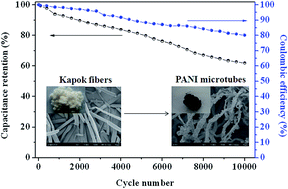Abstract: Hollow micro-/nano-structured materials have been recognized as a promising material for applications in energy-related systems, especially supercapacitors. In this study, polyaniline (PANI) microtubes derived from low-cost natural kapok fibers were facilely fabricated as the electrode materials of supercapacitors. The kapok fiber templates were removed facilely using a NaOH solution after the in situ polymerization of aniline on the outer surface of the kapok fibers. The PANI microtubes etched using 6.0 M NaOH for 60 min exhibit the highest specific capacitance of 667 F g-1 in 1.0 M H2SO4. Interestingly, the as-prepared PANI microtubes showed excellent cycle stability with capacitance retention of 60.7% compared to the origin capacitance after 10 000 cycles. Asymmetric supercapacitors, which were fabricated based on the positive electrode of the as-prepared PANI microtubes and negative electrode of the commercial activated carbon showed a high energy density of 14.1 W h kg-1. The superior electrochemical performance of the PANI microtubes might be due to their hollow structure, which can facilitate the ion diffusion and improve the utilization of the electroactive PANI during the charge-discharge processes. In addition, the residual kapok fiber can effectively relieve the contraction/expansion of PANI during the doping/dedoping processes. KeyWords Plus: HIGH-PERFORMANCE SUPERCAPACITORS; ELECTRODE MATERIAL; CELLULOSE DISSOLUTION; AQUEOUS-SOLUTION; ENERGY-STORAGE; ION BATTERIES; COMPOSITES; SURFACE; NANOFIBERS; NANOTUBE Published in RSC ADVANCES, 6 (72):68302-68311; 10.1039/c6ra16899j 2016 
|

